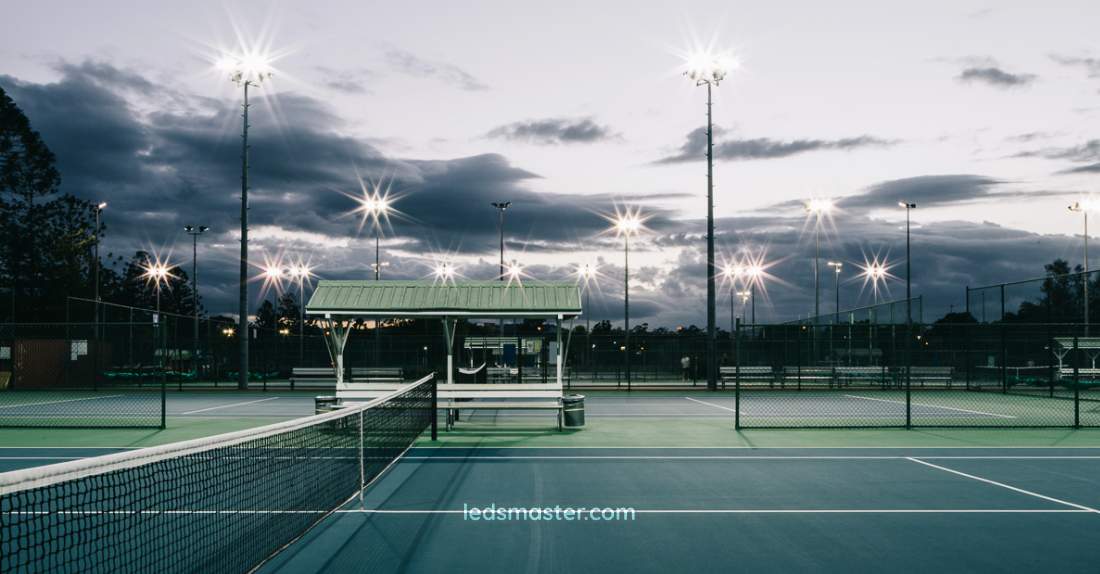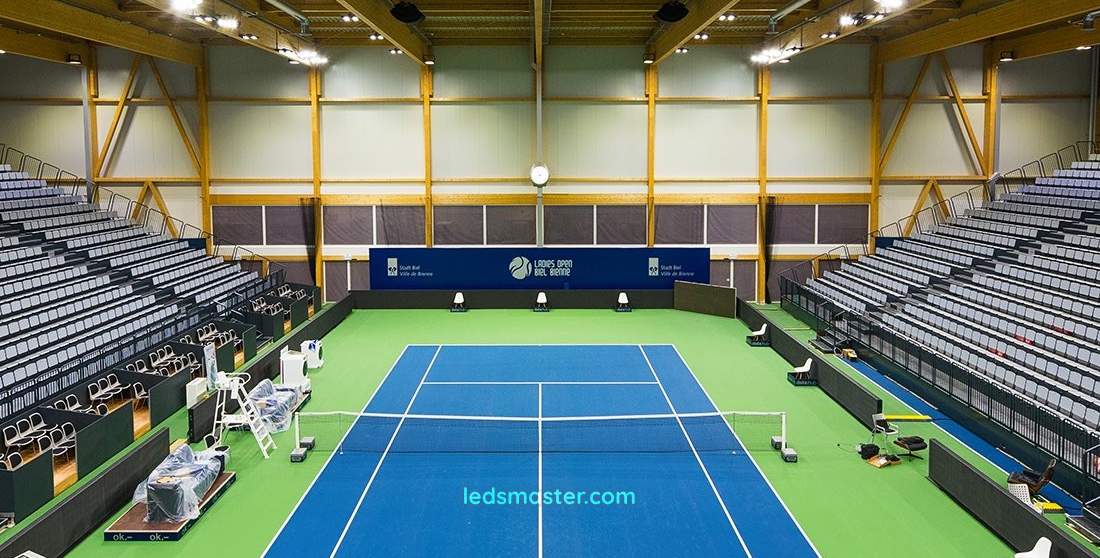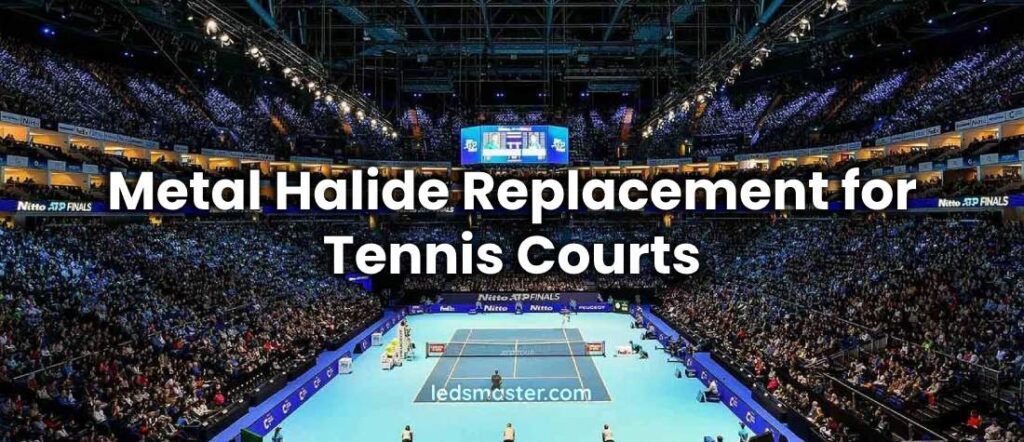Historically, metal halide lamps have been the go-to choice for lighting these spaces. However, with advancements in lighting technology, the drawbacks of metal halide lights have become increasingly apparent, leading many to consider replacing them with modern alternatives like LED lights. This article will explore the issues associated with metal halide lights, such as warm-up time and flickering, and discuss the numerous benefits of replacing them with more advanced lighting solutions.
Table of Contents
ToggleProblems with Metal Halide Lights
Metal halide lights have been a staple in sports lighting for decades, but they come with a set of significant drawbacks that affect their performance and reliability. One of the primary issues with metal halide lights is their warm-up time. These lamps require a considerable amount of time to reach their full brightness, often taking 5 to 15 minutes. This delay can be problematic for tennis facilities that need to quickly illuminate courts for matches or practice sessions, leading to interruptions and delays.
Another common problem with metal halide lights is flickering. Flickering can occur due to voltage fluctuations or as the bulbs age and degrade. This flickering is not only annoying but can also be distracting and even harmful to players, potentially affecting their performance. Additionally, flickering lights can pose a risk to individuals who are sensitive to such disturbances, such as those with epilepsy.
Metal halide lamps also have a relatively short lifespan compared to newer lighting technologies. Frequent replacements are necessary, which can be both costly and labor-intensive. The maintenance involved in replacing these lamps, especially in large tennis court installations, can be significant, often requiring specialized equipment and professional services.
Energy efficiency is another area where metal halide lights fall short. These lamps consume a considerable amount of electricity, contributing to high energy bills for facilities that operate them. The inefficiency of metal halide lights not only affects the bottom line but also has environmental implications, as higher energy consumption leads to increased carbon emissions.

Benefits of Replacing Metal Halide Lights
Switching from metal halide lights to modern alternatives, particularly LED lights, offers numerous advantages that address the aforementioned problems and enhance the overall lighting quality of tennis courts.
Instant On and Off
One of the most notable benefits of LED lights is their instant illumination. Unlike metal halide lamps, LEDs do not require a warm-up period; they reach full brightness almost immediately upon being switched on. This instant lighting capability ensures that tennis courts are always ready for use, eliminating delays and interruptions.
Flicker-free illumination
LED lights also offer superior performance in terms of flicker-free operation. Modern LED technology is designed to provide consistent and stable light output, reducing the risk of flickering and the associated distractions or health risks. This stability is particularly important in a sports setting, where consistent lighting can significantly impact player performance and safety.
Longer Life Span
The lifespan of LED lights is significantly longer than that of metal halide lamps. LEDs can last up to 100,000 hours or more, compared to the 10,000 to 20,000 hours typical for metal halides. This extended lifespan translates to fewer replacements and reduced maintenance costs over time. Facilities can benefit from lower operational disruptions and decreased expenditure on replacement bulbs and labor.
Higher Energy Efficiency
Energy efficiency is another major advantage of LED lights. LEDs consume substantially less electricity than metal halide lamps, resulting in lower energy bills. This efficiency is due to the high luminous efficacy of LEDs, which produce more light per watt of electricity consumed. The reduction in energy consumption also contributes to a lower carbon footprint, aligning with environmental sustainability goals.
Better CRI
LED lights provide better lighting quality in terms of color rendering and light distribution. LEDs offer superior color rendering indices (CRI), which means they can more accurately reproduce the colors of objects compared to metal halide lights. This feature is crucial for tennis courts, where good visibility of the ball and court lines is essential for players and spectators. Additionally, LEDs can be designed to provide more uniform light distribution, reducing shadows and ensuring even illumination across the entire playing surface.
Another benefit of LED lights is their flexibility in terms of control and customization. Modern LED systems can be integrated with advanced control systems that allow for dimming, scheduling, and remote operation. This flexibility enables facility managers to adjust lighting levels according to different events or times of day, optimizing energy use and enhancing the user experience.

How to Replace Metal Halide Lights with LED on Tennis Courts?
Replacing metal halide lights with LED lights on tennis courts involves several critical steps, beginning with assessing the existing lighting system and concluding with testing and fine-tuning the new LED setup. This comprehensive guide covers the entire process, ensuring a smooth transition that maximizes the benefits of modern LED technology.
Assessing the Current Lighting System
Before starting the replacement process, it’s essential to thoroughly assess the current lighting system. Begin by documenting the number and types of metal halide lights currently in use, noting their wattage, mounting height, and fixture layout. Understanding these specifics will help in selecting appropriate LED replacements.
Next, determine the lighting requirements for the tennis court. This includes considering factors such as the level of play—whether recreational, competitive, or professional—and the required illuminance, measured in lux. Ensuring uniform lighting across the entire court is crucial for player performance and safety.
Evaluating the electrical infrastructure is also a vital step. Assess the wiring, circuit capacity, and controls to ensure they can support the new LED fixtures. This evaluation helps identify any necessary upgrades or modifications to the electrical system, ensuring compatibility with the new lighting technology.
Choosing the Right LED Fixtures
Selecting the appropriate LED fixtures is crucial for achieving optimal lighting performance. LEDs offer higher efficiency, so choose fixtures that provide sufficient lumens to match or exceed the light output of the existing metal halide lamps. Typically, LEDs require lower wattage to produce the same amount of light due to their higher luminous efficacy.
Consider the color temperature of the LED lights, which should suit the tennis court environment. Common choices are between 4000K and 5000K, providing a bright, white light that enhances visibility. The beam angle of the LED fixtures is another important consideration, ensuring even coverage and minimizing shadows on the court.
Durability and rating are essential factors when choosing LED fixtures. Opt for fixtures designed for outdoor or indoor sports use, with appropriate IP ratings for dust and water resistance. Robust construction ensures the lights can withstand environmental conditions and provide reliable performance over time.
Planning the Installation
A detailed installation plan is crucial for a successful transition. Develop a new lighting layout if necessary, considering the optimal positioning and spacing of the LED fixtures to achieve uniform lighting. Determine how the new LED fixtures will be mounted; in some cases, existing poles and mounts can be reused, while in others, new mounting hardware may be required.
Plan for any electrical modifications needed to accommodate the new LED fixtures. This may include upgrades to wiring, breakers, and controls, ensuring the electrical system can handle the new lights’ requirements. Having a comprehensive plan in place helps prevent delays and ensures a smooth installation process.
Removing Existing Metal Halide Lights
With the planning complete, the next step is to safely remove the existing metal halide lights. Start by ensuring the power to the lighting system is completely turned off to avoid electrical hazards. Carefully remove the metal halide fixtures from their mounts, which may require lifting equipment for fixtures mounted at significant heights.
Proper disposal of the old lamps is important, as metal halide lights contain hazardous materials. Follow local regulations for the safe disposal of these lamps, ensuring compliance with environmental and safety standards.
Installing the New LED Fixtures
Installing the new LED fixtures involves several steps to ensure they are securely mounted and properly connected to the electrical system. Securely mount the LED fixtures using either the existing mounting hardware or new mounts as planned. Ensure all electrical connections are secure and comply with electrical codes, which may involve connecting to existing wiring or running new wires as needed.
Properly aim and adjust the LED fixtures to ensure even coverage and optimal lighting conditions on the tennis court. This step is crucial for achieving the desired lighting performance and minimizing shadows and dark spots.
Testing and Fine-Tuning the Lighting
After installation, thoroughly test the new lighting system to ensure all fixtures are functioning correctly. Turn on the power and measure the illuminance levels across the court to ensure they meet the required standards and are evenly distributed. Make any necessary adjustments to fixture positioning or aiming to achieve optimal lighting performance.
Implementing Control Systems
Modern LED lighting systems benefit from advanced control options, enhancing their efficiency and versatility. Consider installing dimming controls to adjust the brightness levels based on different usage scenarios, such as training, matches, or maintenance. Scheduling systems can automate the lighting based on the court’s usage schedule, reducing energy consumption when the court is not in use. Remote monitoring and control systems offer added convenience and efficiency, allowing facility managers to manage the lighting system from a central location or via mobile devices.
Conclusion
The replacement of metal halide lights with modern LED lighting solutions on tennis courts offers a range of benefits that address the inherent problems of the older technology. The issues of long warm-up times, flickering, frequent maintenance, and high energy consumption associated with metal halide lights can be effectively mitigated by switching to LEDs. With instant illumination, stable light output, extended lifespan, and superior energy efficiency, LED lights enhance the overall quality and reliability of tennis court lighting. Additionally, the improved color rendering, uniform light distribution, and flexible control options provided by LEDs contribute to a better playing experience for athletes and a more efficient operation for facility managers. As lighting technology continues to advance, the shift towards LEDs represents a smart investment in both performance and sustainability for tennis court lighting.

